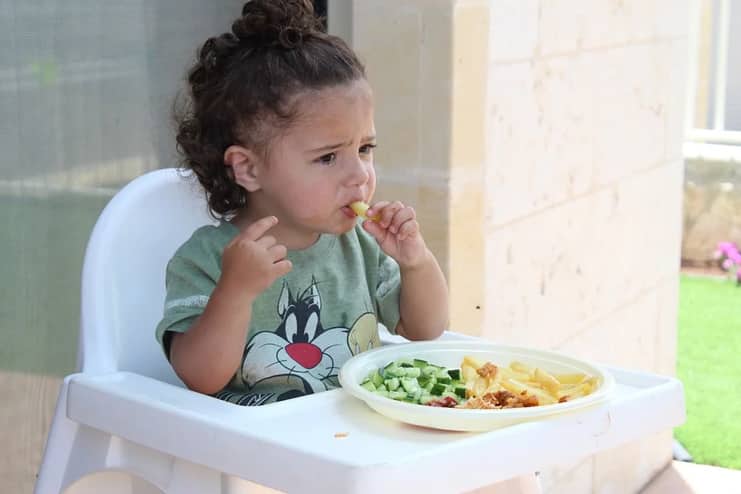Becoming a new parent brings along real challenging circumstances and responsibilities in your life. There will be certain frightening scares for you as a parent while taking care of your child. One of the common worry for parents is choking in infants.
Choking is a condition when the food, breast milk or any other object gets stuck in the baby’s throat which they aren’t able to swallow in. This is a pretty frightening condition as it makes it difficult for the baby to breathe properly.
Well, in this article you will get to know a fair share knowledge about what is choking in babies and what causes choking in babies. It will also cover the ways to stop baby choking.
What Is Choking In Babies?
 Choking is a condition when the food, breast milk or any other object gets stuck in the baby’s throat and they aren’t able to easily swallow it. The condition can also make it difficult for the baby to breathe as well.
Choking is a condition when the food, breast milk or any other object gets stuck in the baby’s throat and they aren’t able to easily swallow it. The condition can also make it difficult for the baby to breathe as well.
Often times, the choking in babies is scary and can even lead to a baby’s death as well because the small airways are easily obstructed. The object gets stuck in the throat and causes choking. This, as a result, blocks the flow of air and cuts down the oxygen level to the brain.
Chocking in infants (R) is due to the results of placing of any kind foreign object in the baby’s mouth. Choking can be dangerous and can lead to life threatening complications.
Why Do Babies Choke?

Well, there are a number of reasons that can lead to choking in infants. But what matters here is that it differs from one to another. It all depends on the overall growth and development of the child.
It depends upon the way the baby takes things around them and what they put in their mouth as they are not aware of what to eat and what not to eat. They just put the objects in their mouth. They don’t care about the size also, so this may result in choking in infants.
The babies and toddlers have limited control over the expulsion of air, so this makes it difficult for them to clear their windpipe with one exhalation, so this can also lead to choking in the windpipe.
The baby is choking when a piece of food or other object gets stuck in the upper airways that help in passing the air to the lungs. Owing to the fact that baby’s have narrower airways, there’s more risk of choking.
Choking also happens or the chances of occurring choking can happen when the food is not swallowed well or chewed properly. This can be because of attempting to eat a larger piece of food or too much food at a time. It does happen when you chew the food incompletely.
The children can choke when they eat too quickly or talk persistently with food in their mouth.
As Per the Research:
- A complete blockage is a medical emergency.
- A partial blockage can quickly become life threatening if the baby cannot get enough air.
How To Know If Baby Is Choking?

Here are few ways that can help you to figure out if the baby is choking. Such as-
- Wheezing
- Gasping
- Inability to talk, cry, or make noise
- Bluish color to the skin
- Panicked look
- Grabbing at the throat
- Inability to breath
- Violent coughing
- A high pitched sound
- Inability to talk
- Passing out
[Read: Baby Hoarse Voice]
What to Do If Baby Is Choking?
Here are some of the ways you can try to prevent your baby from choking. The ways to stop baby choking (R) is categorized based on their age cohort in the babies.
- Babies below 1 year
- Babies above 1 year
1. Babies Below 1 Year:
STEP 1: Check What is Causing The Blockage
- First, you need to figure out what is making the baby choke. You need to find out whether it is an object, food, water or any foreign particle.
- In most of the cases, the baby chokes in the liquid stuff if the babies are below six months.
- Once you know the exact reason behind the choking, you can find the solution. For example, if it is for water or breast milk, then you can use a bulb syringe to remove it. For this, you need to press the bulb end of the syringe and insert the slender tube into the baby’s mouth till the end, in order to release the pressure. The bulb will pull out the liquid that could be causing the baby to choke.
- If it is food or any solid product, then it is not possible to take out with a bulb syringe. You have to find an alternative way but make sure you don’t insert your finger.
- If these things don’t work over, then you have to go for the next level that back blows which is the next step.
STEP 2: Back Blow
- For this, we need to sit down on the chair and then place the baby facing downward on your thigh. Make sure the baby is kept supported on your arm and keep support on the baby head with your left hand.
- Just make the right hand as the base to hold your child and do taps on the upper back between the shoulder blades. The tapping should be firm. It should not be done forcefully.
- Do this for about 5 times and after that, observe the child’s breathing. If you see changes, then stop the back blow otherwise continue with it till the food or the object comes out from the windpipe.
STEP 3: Chest Thrusts
- This is another step that helps a baby to stop choking. If the back blow doesn’t work, then try this one.
- For this, we need to sit down on the chair and then place the baby facing downward on your thigh. Make sure the baby is well supported on your arm and keep support on the baby head with your left hand.
- After that, turn the baby around facing you up. Use the right hand as the base to hold your child and do taps on the upper back. The baby has to look up to you.
- Use the index and middle finger in order to feel the breast bone of the baby. Once you figure it out, put five gentle thrusts on the breastbone.
- After that, pause for a second and observe the baby’s improvement in breathing. If you see improvement, then stop or go for further.
- If the baby is still conscious but appears to be choked, then continue to perform the back blow and chest thrusts method. If the baby shows furthermore symptoms, then get the necessary medical help.
STEP 4: CRP(Breathing Resuscitation)
- This is an advanced way to prevent your baby from choking. The CRP is performed when the rest of the methods don’t work to clear the windpipe. (R) This is done when the baby is unconscious or barely breathing.
- For this, lay the infant on the back on a flat surface that may be on the floor or your lap, etc.
- After that, make the baby’s head straight and straighten their legs. Once it is done, put your mouth over the baby’s mouth closing it with a seal.
- Then blow out two breaths in two rapid successions and then give a break and repeat the same for at least four sets of two blow-outs each.
- While blowing the air, make sure the breath should be powerful enough to make the baby’s chest rise.
- This way of prevention will help to get out the item stuck in the windpipe or will help it to go down the stomach of the baby.
STEP 5: CPR(Chest Compression)
- If the upper step doesn’t work, then go for the next step that is CPR (Chest compression).
- For this, keep the baby in the same position. After that, place your index and middle finger on the breastbone of the baby and perform 30 rapid compressions in one go.
- Make sure you compress enough for the chest to dip 1.5” (4cm).
- When you perform this for 30 rapid compressions, pause for a few seconds before continuing the next set of compressions.
- Don’t do this more than 100-120 compressions in a minute
- After this, observe your child’s breathing to check if it is OK. If it is okay, stop or keep doing this till your child gets the necessary relief.
2. Babies above 1 Year
STEP 1: Check what is causing the blockage
- First, you need to figure out what is making the baby choke. You need to find out whether it is an object, food, water or any foreign particle. The first step remains the same.
- For the case of the toddler, you can put a finger inside the mouth to get out of the object that is causing the choking.
- But, make sure you don’t put the finger down deep.
- If you are not able to see the items that are leading to choking, then just go for the next step.
STEP 2: Back Blow
- You can do the back blow by making the toddler stand in a forward leaning position.
- Give five firm taps with the base of your hand between the shoulder blades that help dislodge the choking item in the windpipe.
STEP 3: Abdominal Thrusts
- This is the next step in preventing baby choking. You can apply this when the toddler is older than 1 year.
- For this, you have to make kids the stand in front of you or you can get the child in the kneeling position.
- After that, curl the finger and make a fist of it. In this, you have to Turn the hand and place the thumb side of the hand little above the belly button of the baby’s stomach. The axis of your finger may point towards the belly.
- Make sure you keep your hand well below the breastbone and between the ribs.
- Following that, cover the fist with your left palm and perform five firm thrusts.
- With the five abdominal thrusts, check with the condition of the baby. If the baby is breathing smoothly, then continue with the abdominal thrusts maneuver or otherwise move to the next level.
STEP 4: CPR (Breathing Resuscitation)
- For this, you have to lay the toddler on their back and the head and neck should be straight.
- After that, cover the mouth of the baby while pinching the baby’s nostrils closed with your index finger and thumb.
- Do it for a couple of blows over a second; after that give a pause and then do it again for about four to five times.
STEP 5: CPR (Chest Compressions)
- If the upper step doesn’t work, then go for the next step that is CPR (Chest compression).
- For this, keep the baby in the same position. After that, place your index and middle finger on the breastbone of the baby and perform 30 rapid compressions in one go.
- Place the heel of your hand on the breastbone of the baby and keep the fingers lifted instead of resting them on the body. This will create pressure on the ribs.
- Do or perform 30 quick successive compressions with the heel of the hand. Compress enough for the chest to sink about 2” (5cm).
- If the baby is breathing properly, then continue with 30 successive thrusts if there is no improvement.
First Aid When Baby Is Choking:

Having first aid idea is important when it comes to choking in the babies. For immediate care, follow through these steps as mentioned around.
- Call 911 if you are alone
- Don’t put your finger into the baby’s mouth. This may push the object further in the baby’s throat.
- Give 5 quick thumps on the baby’s shoulder.
- Place 2 or 3 fingers in the middle of the baby’s breastbone and push down about 1/2 to 1 inch. Do this 5 times if the object is still there.
- Repeat 4-5 times until the baby’s airways are cleared out.
If the baby is not breathing, then follow these guidelines-
- Call 911 right away.
- After that, lay the baby on floor, lap, or on the ground.
- Start the infant CPR
- In this, give 30 chest compressions. In order to do this you have to use two fingers to gently push down on the center of your baby’s chest.
- When the baby’s head and chin is down, check for the presence of the object. Just be careful you should not push the object down further.
- After that, give 2 mins to rescue. Each breath should take about 1 second.
- If the baby doesn’t start breathing, do another 30 chest compressions followed by 2 rescue breaths.
- Continue the CRP until the emergency service arrive.
Call 911:
- Call 911, if you see any of the symptoms
- Continued choking or trouble breathing
- Wheezing or any unusual breathing noises after a choking incident.
- Skin, lips, and nails look blue or dusky
- Child is not alert or is unresponsive
How To Prevent Choking In Babies:

There are a few ways that can help in preventing choking in babies.
Some of the tips include-
1. Properly time the introduction of solid foods
It is important to ensure that you follow caution while introducing solid food. This really works great and can prevent the infant from choking. As per the research and studies, one should at least wait for 6 months before giving solid food to the baby.
2. Don’t offer high-risk foods
Make sure you don’t give babies any kind of high risk food like chunks of meat or cheese, grapes, raw vegetables, or fruit chunks, etc. Unless they are grown enough to chew and shallow it. The baby should avoid hard foods, such as seeds, nuts, popcorn, and hard candy, etc. Offer the food that they can swallow and chew as per their age and growth and development.
3. Process food the right way:
You have to be very serious about the finger food for the baby. The finger foods should be nothing longer than one and a half inches. You have to check with the size and the piece of the food when you are serving your baby. The baby should able to swallow without the risk of choking. It is important to cut the food into a smaller, manageable size.
4. Household items can choke too:
There are certain household things that can lead to choking such as plastic bags, deflated balloons, buttons, and even coins. So, these items should be stored away from the baby’s reach and eyes.
5. Do not rush the baby while eating:
Make sure you don’t run after your baby while he/she is eating. Let them finish it first; otherwise, it can lead to choking in infants. No matter it is liquid or solid. You have to be very careful. Choose the method that decreases the risk of choking.
6. Supervise mealtime;
When the child gets older, don’t allow him or her to play, walk or run while eating. Make the child chew and swallow his or her food properly before talking or walking. The child should not throw food in the air and catch it in his or her mouth or stuff large amounts of food in his or her mouth as that can lead to choking in infants.
7. Carefully evaluate your child’s toys;
Make sure you have a checklist on the toys of your child. Don’t allow your baby to play with latex balloons. This is very dangerous for the child. So, before you buy, just check with the condition of the toys.
8. Give liquid medicine slowly:
A baby does have the risk of choking on liquid medicine as well. So, you need to use a spoon or a syringe dropper to give the liquid to your child in order to prevent choking.
9. Teach them to chew:
The toddlers need to chew their food properly before swallowing. Include the chewing habits as part of their learning process while they are growing up.
10. Never leave babies alone when they are eating:
The Infants and toddlers should not be left by themselves during mealtime. Sit beside the baby/toddler and observe them while they eat.
Choking is a condition when the food, breast milk or any other object gets stuck in the baby’s throat and they are not able easily to swallow it. I hope this article has given you a good amount of information about choking in infants and the ways to stop the baby from choking.










































